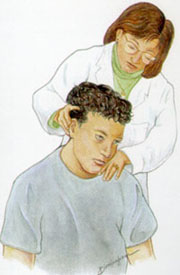Osteopathic study: Treatment cuts pain
Source: PCOM News Release

The Philadelphia College of Osteopathic Medicine has produced what it is calling the first study that provides "objective data" demonstrating how osteopathic manipulative treatment, or OMT, can reduce pain after surgery.
OMT focuses on learning the body's interconnected system of nerves, muscles and nerves, and understanding how an injury or illness to one part of the body can affect another. Doctors in osteopathic medical schools are taught how to use their hands to diagnose injuries and illness, and how to manipulate the musculoskeletal system to encourage the body's natural tendency to heal itself.
The PCOM study, led by Dr. Frederick Goldstein, involved 33 hysterectomy patients at City Avenue Hospital who were all unfamiliar with OMT.
Researchers measured the amount of morphine that was required to treat pain, and the patients' perception of the pain levels, following the surgical procedure.
The study contained two variables. Some patients received morphine prior to surgery and others received a saline solution. After surgery, certain patients from each group received OMT while the others got "sham OMT," where a doctor placed his or her hands on specific areas of the patients, but did not perform any manipulation.
The preliminary results of the study showed OMT had a greater effect than drugs in reducing post-operative pain, and that the osteopathic treatment worked to reduce pain regardless of whether the patients received morphine or saline prior to surgery.
"This study is breakthrough scientific proof that OMT has a crucial role in treating patients who are in pain," Goldstein said.
Goldstein and his team plan to release additional study results within the next six months.
0 Comments:
Post a Comment
<< Home